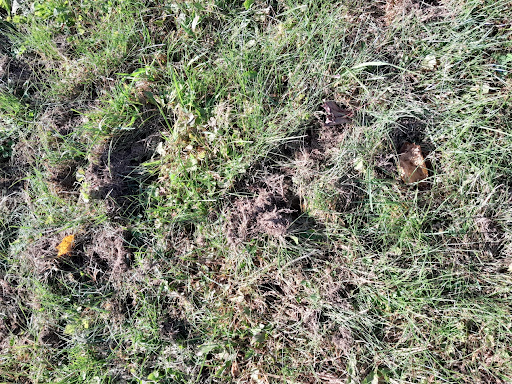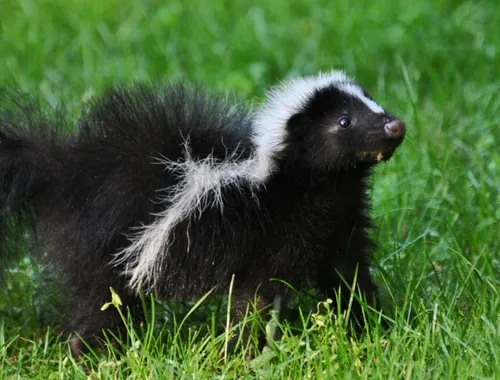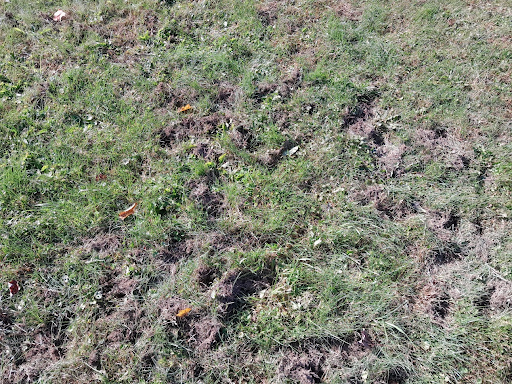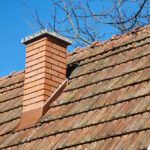What’s digging holes in the lawn?
Thanks to the University of Maryland/Maryland Grows this informative article about trying to figure out what’s digging holes in the lawn.
Damage in the yard
With the transition into the Fall season, I often find myself feeling a mixture of emotions. I feel relief, that another growing season is coming to an end; sadness, that it went too fast; and excitement for what the next year will bring! I am sure that our animal friends also sense the need to prepare for the changing seasons. As such, over the last few days, I’ve been seeing some damage happening in my yard from an uninvited guest!

Can you guess what caused this digging of the grass? This occurred in two different areas of my lawn over the course of a week. I also noticed the exact same digging at my parents’ house in this same time period.
Yikes!
Well, if you guessed a skunk, you are correct! An Eastern Striped Skunk to be exact, which you can learn more about by visiting the Maryland Department of Natural Resources website. These native critters are fairly small with a lot of fluff and a long tail. Their most characteristic marking is their black body with a white stripe down the middle. They are also known for their smell!


As you can probably tell from the photos, my yard is not something that I manage too closely. There is a mixture of grass types and broadleaf plants, so I am not upset that the skunk was foraging for protein sources. I am hopeful that he/she is enjoying some insects, and hopefully consuming some pest larvae like Japanese beetle grubs and slugs.
We encourage biodiversity
We often discuss the benefits of creating a landscape that is rich in biodiversity and habitat for all creatures. So what do we do when we find ourselves inviting a stinky guest to dine on insects and other soil-dwelling critters? Well, for me and my family, we will use this as a teachable moment with our children. We are careful about not leaving anything outside that would be attractive to our new friends. Things like pumpkins for fall decorating, pet foods (or livestock feed), bird seed/feeders, trash cans, or compost scraps can be unintended foods for skunks, which are in the weasel family. At this point, we do not need to take action. My husband has only seen our guest once and it was early in the morning, which is the normal time that he should be foraging. The skunk sighting was also what helped confirm my suspicion of what was digging in the lawn.
Remember that the skunk’s main form of defense is to “spray” a very foul-smelling liquid (butyl mercaptan) from special scent glands. Once they release their “perfume” it leaves them vulnerable with no tools for defense for a few days so that is the last thing that they want to do. They will give you a warning sign of stamping or kneading the ground. If you spy a skunk doing a handstand, you best be on the retreat though. That is the position they use for releasing their spray!
Other animals could be digging holes
Mole or vole tunnels may appear to look similar to this damage. It’s hard to tell from the photo, but this damage was not raised as you see with mole and vole tunnels. Remember, moles eat insects only, but voles will eat plants.
Be a careful detective and look for signs of problems in the landscape, whether that is a pest, plant disease, or mammal. In our instance, we saw skunk scat and then also the actual visitor to confirm what was causing the damage to the lawn. If you need guidance on the management of a nuisance skunk, please check out the University of Maryland Extension website on skunks and never try to capture, pick up, or relocate a skunk without help from a professional.
Happy Autumn!
By Ashley Bodkins, Senior Agent Associate and Master Gardener Coordinator, Garrett County, Maryland. Read more posts by Ashley.
If you are looking to buy or sell your home (with or without a garden), contact Gigi today. Oh by the way, I’m never too busy for any of your referrals!






Recent Comments